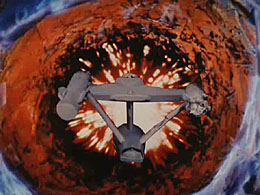
Posted on 04/08/2022 9:36:36 PM PDT by LibWhacker

The James Webb Space Telescope continues to cool down out at its location at Lagrange Point 2, about 1.5 million kilometers from Earth. Since JWST is an infrared telescope, it needs to operate at extremely low temperatures, less than 40 K (-223 degrees Celsius, -369.4 degrees Fahrenheit). But one instrument needs to be even colder.
To operate at peak efficiency, Webb’s Mid-Infrared Instrument (MIRI) must be cooled to a chilly 7 K (-266 C, -447 F). And it will need a little help to reach those frigid temps.
Most of the telescope and its instruments rely on JWST’s massive sunshield as well as passive cooling, taking advantage of the frigid temperatures in deep space. The near-infrared instruments (NIRCam, NIRSpec, FGS-NIRISS) have now reached their target range from 34 to 39 K by cooling passively.
MIRI carries detectors that need to be at less than 7 K to be able to detect longer wavelength photons of infrared light. This temperature is not possible on Webb by passive means alone, so Webb carries an innovative cryocooler, dedicated to the task of cooling MIRI’s detectors so that it can see farther into the infrared than the other instruments.
Previous infrared missions, such as the Spitzer Space Telescope, used a tank of cryogenic liquid helium that acted as a coolant by producing a freezing vapor that cooled the entire telescope assembly. But the vapor was vented to space, and once the supply helium was gone, the ability to cool the telescope was over. Spitzer launched in 2003 and the mission ended in 2020.
But MIRI’s cooler reuses its helium just like the refrigerator in your kitchen continuously recycles its own coolant.
“Over the last couple weeks, the cryocooler has been circulating cold helium gas past the MIRI optical bench, which will help cool it to about 15 kelvins,” explained Konstantin Penanen and Bret Naylor, cryocooler specialists, NASA JPL, in a JWST blog post. “Soon, the cryocooler is about to experience the most challenging days of its mission. By operating cryogenic valves, the cryocooler will redirect the circulating helium gas and force it through a flow restriction. As the gas expands when exiting the restriction, it becomes colder, and can then bring the MIRI detectors to their cool operating temperature of below 7 kelvins.”
This type of recycling cooler also means the lifetime of MIRI instrument, as well as the entire JWST could be even longer than Spitzer’s 16 years. Webb engineers have mentioned a possible 20-year lifetime, or even longer.
Once MIRI reaches the final temperatures, engineers can begin the final phase of commissioning the telescope.
“Getting this instrument cold is one of the last major challenges faced by Webb before the MIRI team can truly relax,” wrote Alistair Glasse, Webb-MIRI Instrument Scientist, UK Astronomy Technology Centre and and Macarena Garcia Marin, MIRI Instrument and Calibration Scientist, ESA. They said the cryogenic cooler will “pull out almost all of the heat left in MIRI’s 100 kilograms (220 pounds) of metal and glass from that tropical launch day morning, three months ago. MIRI will be the last of Webb’s four instruments to open its eyes on the universe.”
Nice article, no lies detected, no wokeness, concise, interesting, inspirational, a refreshing reminder of how things can be.
Maybe because it is made to sense the infrared spectrum, that it might pick up heat easily whenever it momentarily faces the sun, then requiring a cool down before becoming functional again.
it is definitely the Doomsday machine. But it’s a different aspect than I’ve ever seen. Is it from a new, remastered and digitized edition?

Seriously, I will never forget the first time I saw that. I didn’t care about the “star trek” company or brand or whatever. I was so terrorized by it that my mind just froze.
My understanding is that it must NEVER EVER face the sun, even for an instant. The sensitive instruments would be destroyed.
Its orbit around the L2 point combined with the annual revolution around the sun, allow it to examine all parts of the universe, except Earth, since in order to view Earth, it would be facing toward the sun.
When it left earth the telescope was too warm to do it’s job, and the only way to get rid of heat in space is to radiate it away. There’s no convection, no cool breezes (ha!), etc., and radiating heat away is comparatively slow. As far as the ambient temperature of deep interstellar space, I always thought it was just a few degrees above absolute zero. But this close to the sun, it’s another story.
That’s just what I think. I could definitely be wrong about all this. Someone correct me if I am, thx!

Two things from the world of sci-fi really freaked me out - Those bug-eyed aliens in ‘Killers from Space’, and the Zanti Misfits’ from the original Outer Limits series.
Well, it looks as though you are right. Space is cold but near gas giants is very hot.
I remember reading space was in the 70 degrees, though. I guess that was an old article when they didn’t know better, many years ago? Or I dreamt that whole thing up, lol.
https://www.accuweather.com/en/space-news/what-is-the-temperature-in-space-and-why/686238
Sounds like it’s going through menopause.
What could possibly go wrong?
Yes
William Wimdom beamed everybody down, then...
Well Matt Decker only flew in a shuttle craft.
Captain Kirk went in with the melted plastic NCC-1701.
“Gentleman, beam me aboard!”
😜
It’s a great link.
I’ve had it open in my browser since day 1 of this mission.
Fascinating telescope and deployment.
I am guessing a bit here based on space radio reception knowledge. I think, whether it’s RF or IR or any other sensor, it’s about getting adequate signal to noise to be able to ‘detect’.
Cosmic space background noise, which can be measured in temperature or dB (there is a conversion), averages about 2.7 deg kelvin, just above absolute zero. That’s empty space. Add stars and other stuff into the background and the average bumps up to about 30 or 40 deg kelvin. If you were looking at the Earth, the reradiated heat is about 270 deg kelvin. There is a dependency on wavelength as well. The sun puts out about 10k kelvin at our distance from it here.
So to detect for example some star dust 13 billion light years from here that has a temperature seen from here of 40 degrees kelvin, which is lost in the average background, the sensor needs to be cold enough, several degrees colder, to sense the difference. It also needs to be able to be focused enough to not let nearby hotter stuff saturate the picture and drown out what you’re trying to observe.
That’s an explanation from an RF engineers perspective.
I checked it out on YouTube, and you are right and I was wrong.
My grey matter ain’t what it used to be, I’m afraid.🙂
Sorry about that.
My apologies to you, I was wrong!
No worries! Have a blessed day!
Disclaimer: Opinions posted on Free Republic are those of the individual posters and do not necessarily represent the opinion of Free Republic or its management. All materials posted herein are protected by copyright law and the exemption for fair use of copyrighted works.